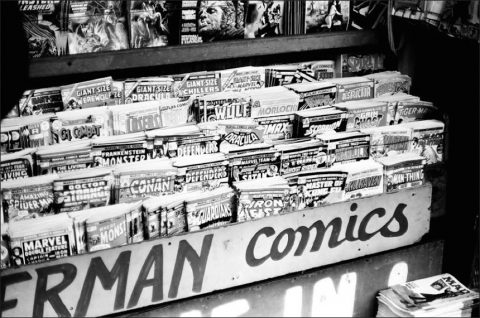One of the oldest and most frequent questions debated around comic shops is “when does the Silver age of comics end and the Bronze age begin”. There are always different opinions and some lively debate in terms of people defending their opinions/positions on the matter. Many people had very strong feeling about this, others like myself didn’t understand the need to split them into specific ages beyond the decade year in which they came out (i.e. the 50’s or the 80’s).
Over the Christmas holidays this subject raised its head once again when I was asked who was Spider-Man’s first big Bronze age villain. My immediate answer was Morbius in Amazing Spider-Man #101. Alternative answers immediately chimed in: the Punisher, Hammerhead, Silvermane, and the Prowler. Still many different opinions. No real clear answer, as there was quite a difference of opinions on when the Bronze age actually begins.
When I got home I remembered Overstreet has definitions for each age of comics in their annual price guide, and I quickly look them up. The 47 Overstreet Price definition are:
The Silver Age: all comics published from 1956-1971.
The Bronze Age: all comics published from 1970-1984.
Sigh! No help from the referee on that one.
We are left with the Grey age of comics. I would have called it the 50 Shades of Grey age but that was already taken. Comic books published in 1970 and 1971 without a definitive Olympic medal colour to call there own.
I confess I have used and heard of number of different versions of when the whole Silver/Bronze age changeover took place. I’ll list some of the versions I have heard.
Price- The beginning of the $0.15 or $0.20 cover.
By a specific book – Conan #1, Amazing Spider-Man#121 or #129 (both way too late), House of Secrets #92, Detective #395, and Green Lantern #76 all receive support in this regard. Overstreet seems to have moved away from a specific book defining the beginning of an age. Showcase #4 used to be specifically named as the beginning of the Silver Age, but this has changed over the years to a time -bound age.
Year – the Bronze age begins in 1970, 1971, or 1972. I have seen/heard support for all three.
Personally, I think Overstreet would have it right if they changed their Silver age definition to 1956-1969 and the Bronze age 1970-1982. I think of the Copper age in 1983 and 1984.
So where does your Silver age collection end and Bronze age collection begin?




In this case it might be helpful to ask what “is not Silver” rather than what “is Bronze”. Think about comics during this time and ask if they “feel like” they belong to the era of Showcase’s and Brave & Bold’s first appearances, Kirby’s heyday, etc. If they feel more modern, then maybe they will help you set the boundary. That’s why I like Green Lantern #76 – this is the start of the seminal “first SJW” that doesn’t at all seem to belong to the Silver Age. I don’t feel strongly about whether the boundary should be pushed back to the beginning of 1970 as you suggest with Detective #395, but I think it could be argued that this issue was more of a “return to the early Golden Age” than a modern take on Batman. The first non-code Amazing Spider-Man is #96 from May 1971 is clearly Bronze, so that sets another boundary.
This vagueness causes problems on eBay, which is why I am leery of using their “age” refinements.
I tend to think about “collecting ages” rather than these Gold/Silver/Bronze/etc. Ages. These are periods defined by relative scarcity and/or scarcity in high grade. For example, I am sensitive to the demarcation between the “lean” WWII period and the “pre-victory” WWII period, which is around mid-1944.
i go with the price change from 12 to 15 cents.furthermore, i view the marvel expansion (Conan Tomb of Dracula, Amazing Adventures/ Astonishing Tales and others)as key books that usher in the new age
1971 just sounds too late, January 1970 could work as the start of the Bronze Age. The 15 cent price change is a very visual cue and could work too.
Some books were ahead of the curve, titles like Detective may have ushered in the Bronze Age before say the Fantastic Four so I don’t think we can pin it down by “feel”.
Maybe it will always vary by title?
I go with Silver Age being 1956-1969. Mostly I have Bronze Age 1970-1983, and Copper Age 1984-1993. There are a few occasions where I might swing a little on a certain title or when there is a key milestone issue on some Bronze and Copper Age scenarios.
All well reasoned comments here, and everyone a little different. I was informed by a young collector over the weekend that I was all wrong on the bronze-age. It is 1970-1985 – wiki told him so:).
I’d have to agree with Steven with a lot of his points . maybe a little earlier , though . I think that the bronze age slowly started when Carmine was DC’s publisher and started a whole bunch of titles in 1968 and 1969 in order to compete with Marvel getting better distribution and increasing their title output ! both publishers thinking were starting to change , and imho , when Roy Thomas convinced Stan to publish Conan 1 . I remember all of my collecting friends were very excited when Conan 1 came out . so I can definitely see the beginnings of the bronze forming in the late 60’s and by 1970 was in full bloom !
For me it’s always been the change to 15 cents that has been the Bronze Age marker.
wouldn’t it be great to actually sit with you all at a big round table discussion of this question…? like the sunday talk shows.I would put anybody on this thread ahead of any of kevin smith’s crew.
Like the Silver Age, which for DC began with Showcase #4 in 1956 and which for Marvel began with Fantastic Four #1 in 1961, I believe the Bronze age demarcation can also be defined by the arrival of certain milestone issues, which had lasting impact and acted either as catalysts or harbingers of significant change to the art form for years to come. When viewing the boundary from this perspective, Green Lantern #76 (April 1970) and Conan The Barbarian #1 (October 1970) are logical choices. When Denny O’Neil and Neal Adams mic-dropped their mind-blowing new look at the world through the eyes of super-heroes and super-heroes through the eyes of the world, a stratospheric benchmark was set for quality and realism in comics storytelling, which influenced the medium for decades. With their run on Conan, Barry Smith (now Barry Windsor-Smith) and Roy Thomas created the template for the sword and sorcery genre, which in comics did not exist in any substantive form prior to Conan #1, and after which became ubiquitous in many forms of media throughout the 1970’s and beyond. This also marked the beginning of Marvel’s years-long expansion into other types of fantasy comics. Some additional punctuation is added by the fact that Jack Kirby’s last full length comics stories for Marvel before he left for DC were Silver Surfer #18 and Fantastic Four #102, both cover dated September 1970; the month before Conan #1 was published.
4.5